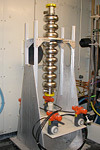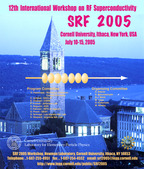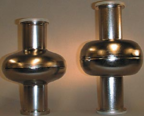SRF News: Before 2009
Cornell Group Achieves Milestone in Superconducting Cavity Test (06/01)
The International Linear Collider (ILC) is a proposed electron-positron collider with the highest energies ever achieved in such an accelerator. The design has two 12 Km (7 miles) linear accelerators facing each other with collisions occurring in the center between them. In order to achieve the desired energy of 250 GeV (250 billion electron volts) in each beam, superconducting accelerating cavities must provide a sufficient energy "kick". In early June, the Cornell SRF group successfully processed and tested the first US ILC cavity. The cavity is now ready for the final stage of cleaning, called electropolishing, and is on track to achieve the ILC goal of 35 MV/m (MegaVolts per meter). See full press release from ILC.2005 International Workshop on RF Superconductivity, Cornell University, July 10-15, 2005 (07/16)
2005 International Workshop on RF Superconductivity, Cornell University, July 10-15, 2005 The 12th International Workshop on RF Superconductivity (SRF 2005) was held July 10 – 15, 2005 on the Cornell University campus, Ithaca, NY, USA. More than 200 scientists and engineers from 14 countries participated in SRF2005 and made the workshop so successful. The workshop was hosted by the Laboratory for Elementary-Particle Physics. For further information, please click here.Records fall at Cornell (CERN Courier article) (06/07)
Experiments at Cornell are breaking records for accelerating gradients and Q values in superconducting radio-frequency cavities, reports Hasan Padamsee.Improvements in our understanding of the mechanisms that limit accelerating gradients or electric fields, together with technological advances from worldwide R&D, have steadily increased the performance of superconducting cavities over the past decade. Full article




